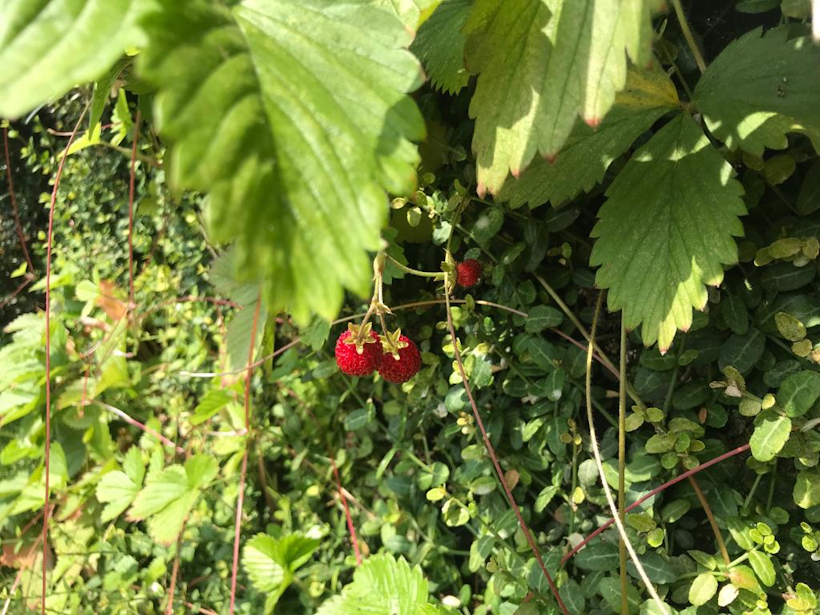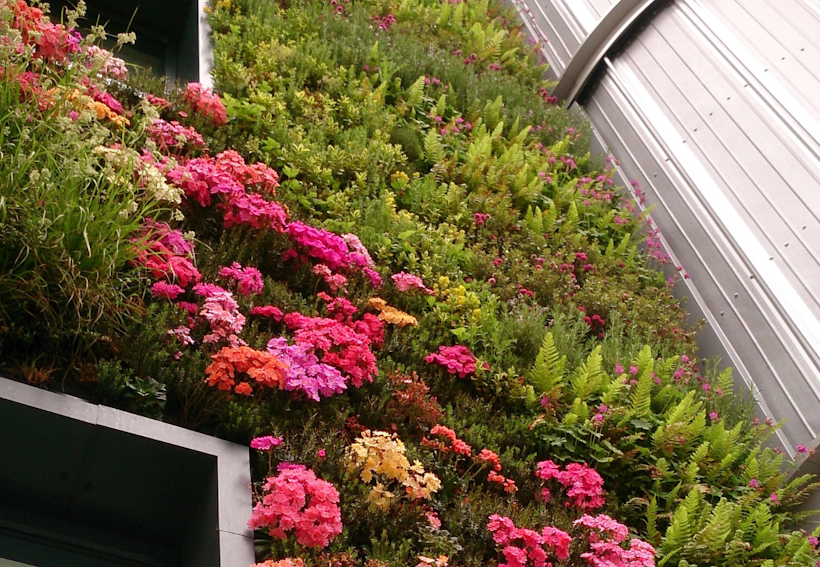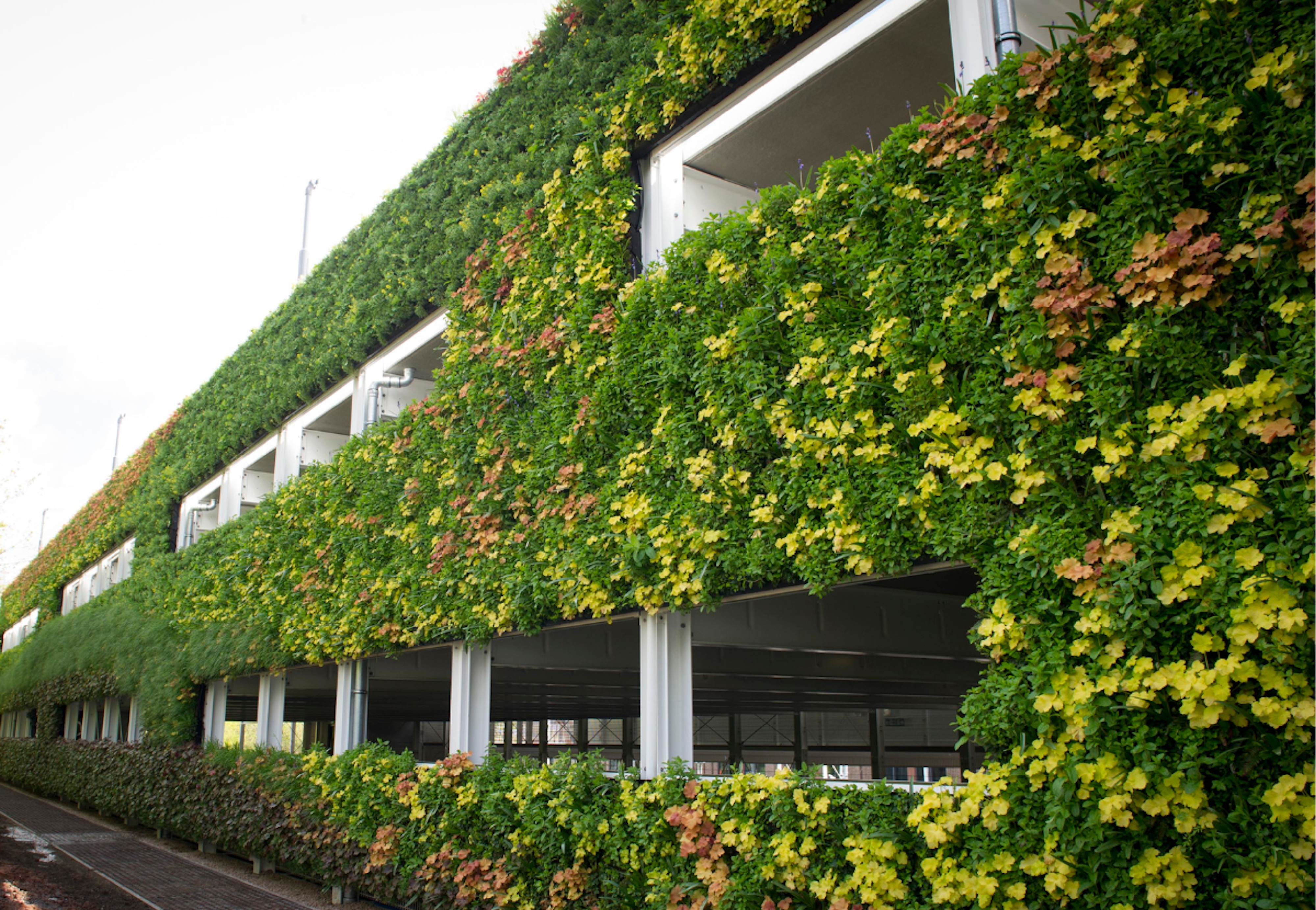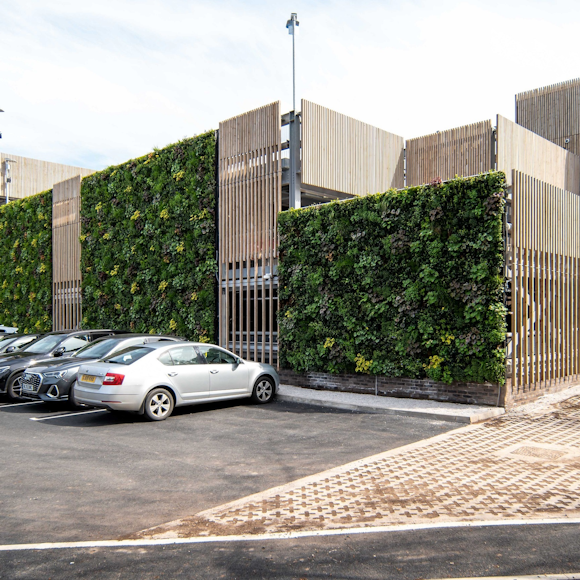If you are an architect, or anyone else proposing a living wall as part of a concept, you and your client will want to know what to expect from it in terms of coverage throughout the year and what benefits the chosen vegetation will have. At Viritopia, we design, grow, integrate, and maintain living wall systems to support architects in not only creating beautiful walls that will have full coverage all year round, but will also achieve ecological and regulatory requirements. So, as experts in our field, we are going to share with you what each season will bring for your Viritopia living wall.
Each Viritopia living wall design is unique with different choices of vegetation on every wall to suit its location best. However, we will give you an idea of what plant life your wall may see each season based off one of our largest living wall designs currently in progress.
Living wall backdrop vegetation:
Our living walls will always have backdrop vegetation which will be present all year round to ensure a fully structural planted wall, and ecological habitats for sheltering wildlife in the colder seasons. These evergreens also play a big role in purifying the surrounding air, protecting infrastructures from dust and weather damage, and controlling internal and external temperatures. Here are our frequently used evergreen backdrop species, and their individual benefits:
- Buxus Sempervirens (Common Box) – A green bush like evergreen that is perfect for providing winter shelter to insects.
- Sarcococca Confusa (Sweet Box) – An evergreen species providing dense foliage for hibernating insects.
- Heuchera ‘Marmalade’ (Coral Bells) – An orange evergreen that offers an ecological habitat to butterflies.
- Heuchera ‘Purple Petticoats’ (Coral Bells) – A purple shrub which provides an ecological habitat for insects and butterflies.
- Heuchera ‘Lime Ricky’ (Coral Bells) – A bright green shrub offering an ecological habitat for insects and butterflies.
- Blechnum Spicant (Hard Fern) – A spikey evergreen habitat for various species.
- Pachysandra Terminalis (Japanese Pachysandra) – Evergreen species with bright green leaves providing ecological habitat.
- Carex Morrowii ‘Variegata’ (Japanese Sedge) – Can act as a filter to remove pollutants.
- Euonymus Microphyllus (Japanese Spindle) – An evergreen habitat, providing insects shelter in the winter.
- Hedera Helix ‘Green Ripple’ (Common Ivy) - Native cultivars providing evergreen shelter for local insects. Has dust absorbing properties.
Throughout the year, these evergreens will keep the living wall looking ‘green’, with each season bringing added colour to this backdrop.

What to expect from your living wall in the winter:
In the winter, your living wall will be mostly made up of the backdrop evergreens, which will keep the wall looking full, provide shelter for hibernating insects and wildlife, and will regulate the internal temperature of the building. There are, however, a few seasonal plant species that you may see during the winter. These include:
- Viola Odorata (English Violet) – A native English species which provide for the local flora (If your wall is UK based).
- Galanthus Nivalis (Snowdrop) – White petaled plants providing an early source of nectar to bees and other pollinators.
What to expect from your living wall in the spring:
In the spring, some seasonal yellows and purples will start to appear through a range of flora plants. Here are our recommended spring time plants:
- Rosmarinus Officinalis (Rosemary) – These purple plants will provide a source of nectar and provide habitats for insects.
- Viola Odorata (English Violet) (also common in winter) – A native English species which provide for the local flora (If your wall is UK based).
- Narcissus ‘Tete a Tete’ (Daffodil) – A bright yellow flower, a symbol of UK springtime, these will provide an early source of nectar to pollinating bees.
- Primula Veris (Cowslip) – Another yellow flower, also providing a source of nectar whilst also being a habitat for insects.
- Armeria Maritima (Sea Thrift) – Perfect foraging plant and a source of nectar.
- Hyacinthoides non-scripta (Bluebell) – A bright plant that provides an early source of nectar.
- Vinca minor ‘Bowles Purple’ (Bowles Periwinkle) – An evergreen plant with continual flowers through the spring and summer.
- Bergenia Cordifolia (Elephant Ears) – an evergreen ecological habitat and source of nectar & forage.
- Hebe Pingufolia ‘Pagei’ (Shrubby Veronica) – An evergreen ecological habitat.
- Alyssum Spinosum (Spiny Madwort) – A bushy plant with pink flowers which provides a source of nectar.
- Fragaria Vesca (Woodland Strawberry) – A native UK species providing fruit for birds and flowers for insects.

What to expect from your living wall in the summer:
In the summer, a range of flowering seasonal plants will appear, providing nectar and habitats for insects and wildlife. Here are our frequently used summer plants, and their benefits:
- Hypericum Hidcote (St John’s Wort) – A source of berries for birds and a nectar for pollinators.
- Hyssopus Officinalis (Hyssop) – A purple flowered shrub that provides a source of nectar.
- Luzula Nivea (Snow-white Wood-rush) – A local northern English flora plant which provides nectar and habitats to insects.
- Mentha Spicta (Spearmint) – Provides forage for bees and other pollinators, and also provides a natural habitat.
- Thymus Vulgaris (Common Thyme) – A bushy flora plant providing forage and natural habitat.
- Hebe Pingufolia ‘Pagei’ (Shrubby Veronica) (Also common in spring) - An evergreen ecological habitat.
- Armeria Maritima (Sea Thrift) (Also common in spring) – Perfect foraging plant and a source of nectar.
- Vinca minor ‘Bowles Purple’ (Bowles Periwinkle) (Also common in spring) – An evergreen plant with continual flowers through the summer.
- Geranium Macrorrhizum (Bigroot Geranium) – Excellent habitat for butterflies and local UK ecology.
- Hebe ‘Red Edge’ (Shrubby Veronica) – An evergreen species that provides an ecological habitat.
- Primula Chungensis (Candelabra Primula) – A yellow flora plant that provides a source of nectar and insect habitat.
- Geranium Rozanne (Cranesbill) – A vibrant purple flora plant that provides habitat for butterflies and local UK ecology.

What to expect from your living wall in the autumn:
In the autumn, the vibrant floral summer species will slowly come out of season and more leafy or white floral plants will come through. These species will be vital in providing shelter and ecological habitat in preparation for winter. Here are our recommended autumn species:
- Hebe Salicifolia (Willow Leaf Hebe) - This bushy evergreen with white blooms will provide ecological habitat.
- Hyssopus Officinalis (Hyssop) (also common in the summer)– A purple flowered shrub that provides a source of nectar.
- Vinca minor ‘Bowles Purple’ (Bowles Periwinkle) (Also common in spring and summer) – An evergreen plant with continual flowers through the summer into the autumn.
- Hebe ‘Red Edge’ (Shrubby Veronica) (Also common in the summer) – An evergreen species that provides an ecological habitat.

What will each season bring for your Viritopia living wall: key takeaways
Although this list is not a be-all and end-all, it will give you a good idea of what sort of plants to choose and how they will each provide habitat, nectar, and coverage over each season of the year. If you want more guidance on which seasonal plants are best for your living wall, seasonal plants, get in touch with our expert team today.
Design a living wall with Viritopia and reap the benefits
Are you in the early stages of development? Are you looking to capitalise on environmental assets? Are you interested in learning more about living walls? Then look no further. Our team at Viritopia have you covered.
At Viritopia, we use over 20 years’ experience designing and maintaining green infrastructure, we form detailed analysis on how a scheme is to meet regulation. We aid a faster planning process and provide you with what’s needed to take your project to the next level. Learn more about our living wall consultancy right here.

